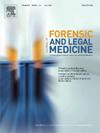超越司法和科学决策过程之间的距离:基于证据的医疗相关感染职业责任评估预测算法
IF 1.2
4区 医学
Q3 MEDICINE, LEGAL
引用次数: 0
摘要
背景最近,意大利最高法院于 2023 年 3 月 3 日宣布了第 6386 号判决,HAI(医源性感染)成为判决的主题。该判决提供了三项标准,即时间标准、地形标准和临床标准,以确定医疗机构是否对患者感染院内感染负有责任。因此,医疗机构有义务证明其履行了立法者具体规定的一系列预防性卫生措施。在此,将这些标准("司法标准")与传染病专家审查的临床标准("传染病标准",即方法比较了司法部远程服务门户网站的两个回顾性队列;从意大利 2020-2022 年三年期间有关革兰氏阴性菌医院内感染索赔的判决中推断出 51 名患者。另一方面,我们从巴里大学医院的电子数据库中提取了 349 名在同一时间段内受革兰氏阴性菌感染的患者。然后,将 "法学 "标准和 "传染病 "标准应用于整个队列,并对来源队列进行了分层,对医院内感染或非医院内感染进行了分层。通过接收器操作特征曲线(ROC)和曲线下面积(AUC)评估了标准的预测价值。结果总体而言,法医队列中明确的鼻腔感染(根据最终判断或临床记录出院信)发生率为 84%,"真实世界 "系列中为 46%。此外,通过将两个标准汇总到一个分类系统中,生成的 ROC 曲线是 AUC 最高的[0.9488(95%CI = 0.928-0.969)]。有趣的是,ROCs 曲线显示,至少有一个法学标准加上至少两个传染病标准,其预测价值可与 2 或 3 个法学标准相媲美。此外,结合 "司法 "和 "传染病 "标准的综合评分的使用为技术顾问提供了一个高质量的工具,可用于弥补临床文件的不足,通过对发生院内感染时的职业责任诉讼做出判断。这揭示了以科学严谨的态度面对全球司法调查的可能性。本文章由计算机程序翻译,如有差异,请以英文原文为准。
Beyond the distance between juridic and scientific decision-making process: An evidence-based prediction algorithm for professional liability assessment in healthcare-associated infections
Background
HAIs (Healthcare-Acquired-Infections) have been recently the subject of judgment n. 6386 pronounced on 3rd March 2023 by the Italian Supreme Court. This sentence provided three criteria to determine whether a health facility is responsible for the patient contracting a nosocomial infection, i.e. time criterion, topographical criterion and clinical criterion. Accordingly, the healthcare facility is obliged to prove the fulfillment of a series of preventive hygiene measures specifically detailed by the legislator. Herein, the positive predictive value of these criteria (“juridic criteria”) in the identification of professional liability for nosocomial infections was evaluated in comparison with clinical criteria reviewed by Infectious Disease specialists (“Infectious-Disease criteria”, i.e. presence of a Multidrug Resistant Organism (MDRO); development of surgical site infection; inadequate antibiotic therapy; inadequate disinfection).
Methods
Two retrospective cohorts were compared from the Portal of Telematic Services of the Ministry of Justice; 51 patients were extrapolated from Italian judgments concerning claims for Gram-negative nosocomial infections in the three-year period 2020–2022. On the other side, from the electronic database of University Hospital of Bari we extracted 349 patients affected by Gram-negative infections in the same timespan. Both “juridic” criteria and “Infectious-Disease” criteria were then applied to the full cohort after stratification for cohort of origin and after stratification for nosocomial or non-nosocomial infections. Predictive value of criteria was evaluated through receiver operating characteristic (ROC) curves and area under the curve (AUC).
Results
Overall, the incidence of definite nosocomial infections (according to final judgement or clinical records discharge letter) was 84 % in juridic cohort and 46 % in “real-world” series.
Data suggested that the presence of all three juridic criteria [ROC AUC = 0.944 (95%CI = 0.924–0.963)] or the four clinical criteria [ROC AUC = 0.948 (95%CI = 0.928–0.969)] predicted well a case of nosocomial infection with professional liability.
Moreover, by summarizing both criteria in a single classification system, the generated ROC curve (was the one with the highest AUC [0.9488 (95%CI = 0.928–0.969)].
Accordingly, further tests were performed, evaluating the predictive value of one juridic criterium plus at one of more Infectious-Disease criteria. Interestingly, the ROCs curves demonstrated that the presence of at least 1 juridic criteria plus at least 2 Infectious Disease criteria reached a predictive value comparable to 2 or 3 juridic criteria.
Conclusions
The results highlight the efficiency of new criteria laid down in the judgment of the Italian Supreme Court to attribute liability for nosocomial infection despite the disputed distance between juridic and scientific decision-making process. In addition, the use of a combined score combining “juridic” and “Infectious-Disease” criteria provides a high-quality tool to be used by technical consultants to make up for lack of clinical documentation by passing judgments concerning litigation about professional liability in case of nosocomial infections. This sheds light on the possibility to face worldwide judicial inquiries with scientific rigor.
求助全文
通过发布文献求助,成功后即可免费获取论文全文。
去求助
来源期刊

Journal of forensic and legal medicine
MEDICINE, LEGAL-
CiteScore
2.70
自引率
6.70%
发文量
106
审稿时长
57 days
期刊介绍:
The Journal of Forensic and Legal Medicine publishes topical articles on aspects of forensic and legal medicine. Specifically the Journal supports research that explores the medical principles of care and forensic assessment of individuals, whether adult or child, in contact with the judicial system. It is a fully peer-review hybrid journal with a broad international perspective.
The Journal accepts submissions of original research, review articles, and pertinent case studies, editorials, and commentaries in relevant areas of Forensic and Legal Medicine, Context of Practice, and Education and Training.
The Journal adheres to strict publication ethical guidelines, and actively supports a culture of inclusive and representative publication.
 求助内容:
求助内容: 应助结果提醒方式:
应助结果提醒方式:


